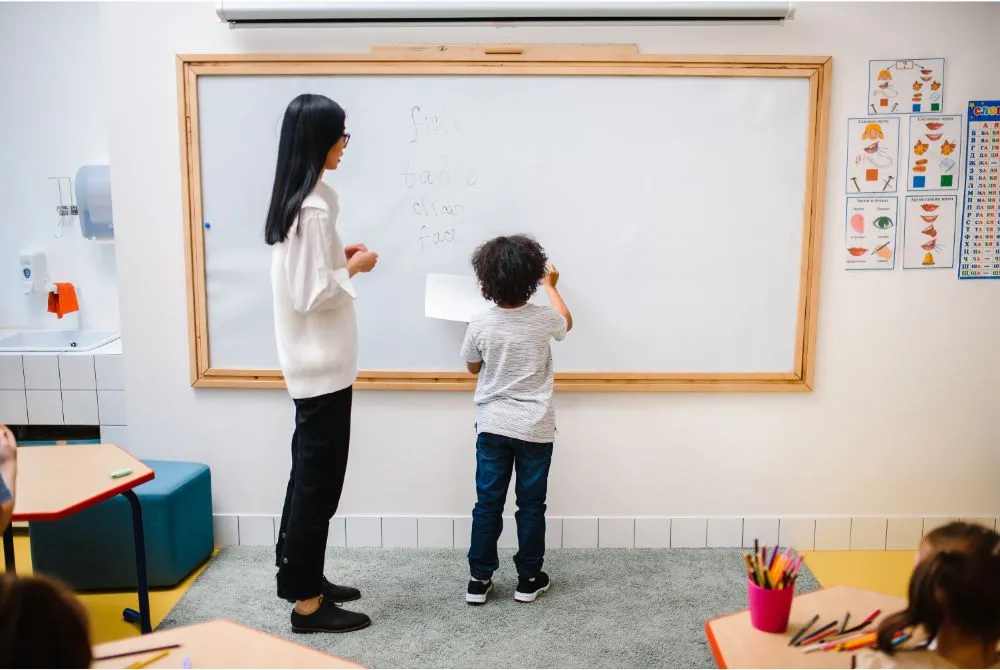Are you looking for some fresh and fun morning meeting activities to get the morning off to a great start?
I have brought you some ideas that I personally tried in my class and saw amazing results. These focused ideas of games and activities turned out to be the best to bring out the hidden abilities and qualities of students and also to keep children’s minds fresh and relaxed.
So, seeing this, I planned to share these creative ideas with you. Try them in your class. Through these activities, I’ve especially focused on student’s social-emotional learning along with relaxation and fun.
Spice up your morning with these morning meeting activities
All these activities are flexible and you can mold them as per your convenience.
Friendship Fusion:
Have two random students stand in the class. Ask them to name their best friends. Take turns asking them what good qualities they like about their best friends. Then look for the best traits they both have in common. I love this activity because it is a beneficial activity to develop and highlight good friendship qualities among students.
Positive Affirmation Circle:
Starting from the last student and moving forward, ask each student, in turn, to speak one positive affirmation within thirty seconds, and so take turns completing the class. I significantly suggest this activity because it can be very beneficial and effective in creating a space of positivity in student’s minds.
Success Schedules:
Ask the best-performing student in the class to share their daily routine and timetable, including weekends, with the class. The next day, ask the second and then the third topper of the class. Put it as an example in front of students of how to set a routine and schedule to perform well. A practical example before their eyes will stimulate them to take action.
Leadership Spotlight:
Randomly line up three students from the class and ask the whole class who they think is the best to fulfill the position of class leader. Then the leadership qualities of the student whose name comes up the most should be highlighted in front of the class. This activity is very important for me.
Story Spark:
Pick a child at random from the class. Tell the beginning of any real or imaginary story, and ask that child to complete the story. Tell him a little bit about how the story is supposed to end. I think it can be a great way to spark and shine a student’s creativity and imagination.
The Kindness Challenge:
I made three groups of students in my class and challenged each group member to perform one act of kindness for the day. The next day, I asked children in alternating groups to share their acts of kindness, and rearranged groups with similar acts to repeat the cycle. This thing promoted the children’s spirit of kindness so much that the results were surprising. I suggest you try this idea. Kids will be filled with feelings of kindness and compassion.
Compliment Chain:
Ask the child sitting at the front of the class to give a genuine compliment to the child sitting next to him, then to the child sitting behind him, and so on. Thus, create a chain of compliments for the whole class. I personally love this activity as it fosters positivity and a community environment in the class.
Question Quest:

As a teacher, you know very well that questions enhance students’ ability to think, understand, and reflect. So it can be a great addition to morning meeting activities. Ask students questions that make them think. This will increase their creativity. And it is a fact that the more the brain is used, the more it expands. For example, you can ask, “If you have a conflict with someone, how will you resolve it?” or “Have you ever used a SMART goal strategy in your life?”
Related article: 60 Morning Meeting Questions (For an energetic start)
Memory Tray:
If I want to improve children’s memory and sharpen their observation skills, I will definitely consider this activity. The activity is, “Place several small items on a tray and briefly show them to the students. Then cover the tray and have students write down or remember as many items as they can.”
Alphabet Categories:
This activity is very effective in improving children’s vocabulary. This involves dividing the different things into categories and asking the students to take turns making words for each category alphabetically within a time limit. See how many words your students can make without repetition of any word. This way, as they think, their vocabulary will grow, and they will have fun as well.
Peer-Led Learning:
Choose a student from the front of the class and suggest a topic to him, for example, acts of kindness, conflict resolution, etc. Ask the child to write three simple questions on the whiteboard about one topic. Ask the student sitting at the end of the class for answers. Then turn to the child second from the front and the child next to the last. In this way, this activity will create the best qualities in kids and teens.
Silent Ball:
If you want to increase focus in your kids, this activity is recommended. All you have to do is have all the students sit in a circle and give them a softball. One child will pass the ball to the other. Tell them that if someone makes a noise or the ball falls, then he will be out. Playing like this, the last child left will win.
Emoji Charades:
This activity can improve kid’s effective expression of their emotions. It enables them to express their feelings through facial expressions and body language. To practice this, draw different emojis on cards and take turns acting out the emotions expressed within those emojis. It’s both fun and a learning process.
Pass the Word:
This activity is designed to focus on the active listening skills of students. Have the students sit in a circle. Whisper a simple phrase in one child’s ear. Then that student will whisper the same phrase to the child next to them, and so on. When it reaches the end, ask the last child to say the phrase out loud and compare it with the first one. Is this the same phrase that you spoke in the ear of the first child? Clap loudly, and let the children enjoy.
Story Retelling:
Like the activity above, this also promotes active listening in another way. What you do is read a short story or passage aloud to the class. Then ask a student from the class to stand up and repeat it, focusing on the key details and events. Apart from this, you can also ask questions from within the story.
Tips to run an effective morning meeting
You may have several choices for the morning meeting, but it depends on you which way you choose. Set a routine that’s easy because it’s hard to stick to a difficult routine.
Choose activities that are easy and rewarding for you and your students, both in terms of enjoyment and learning.
For this purpose, we have compiled some practical tips for you, which are given below. You and your students can benefit equally.
Establish a Routine:
When your students see what you are doing, they will naturally be inclined to do the same. Teach them regularity and punctuality by setting yourself as an example. Set a start time and duration (from 5-20 minutes) and stick to it on a daily basis. Be consistent in your words and actions.
Greet Each Student:
Personal greetings can make students feel valued and respected. A sense of community within the classroom thrives when students feel valued. Along with education, you also have a hand in better training of children and making the classroom environment the best it can be.
Related article: Morning Meeting Greetings (30 Experimental Ideas)
Set Expectations:
Clearly communicate to your students what behavior you expect during this time. What changes you want to see after this time. What social and emotional skills you want to improve with this routine. If you keep an eye on the end results, then the difficult path will become easier for you.
Encourage Participation:
If it’s done in a fun way, everyone will participate, but you still have to make sure those who don’t want to get involved are included. Provide opportunities for all students to participate in the meeting, and everyone should have an equal chance to get involved. A sense of esteem and a sense of humiliation have profound effects on the overall performance of students.
Acknowledge Achievements:
When anyone celebrates achievement, he sets a tone to get ready and welcome new achievements to come. Take time to celebrate accomplishments, whether they are academic or extracurricular, big or small. This can be a source for generating positive signals of success.
Reflect and Review:
Reflection and review help reinforce key points and ensure that students leave the meeting with a clear understanding. Reflect on what was expected and what has been achieved. And also consider what needs to be improved and what could have been done better. Yes, I know these things may seem simple, but their impact can be clearly seen after doing them.
If you carry out the activities and tips described in this article properly and with due attention, you will surely benefit yourself and your students. You will be able to make your morning meeting enjoyable and full of learning.
For your convenience, I have compiled these morning meeting activities into a regular PDF format. You can download and print this PDF for free.
